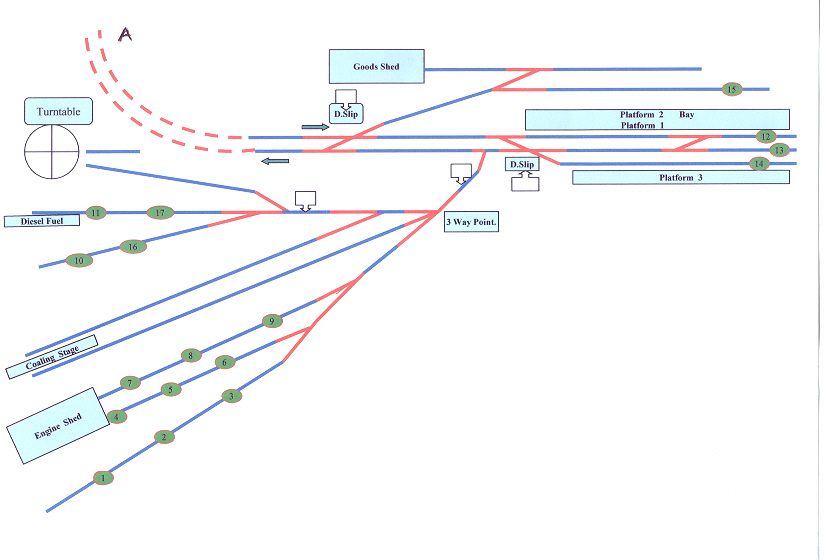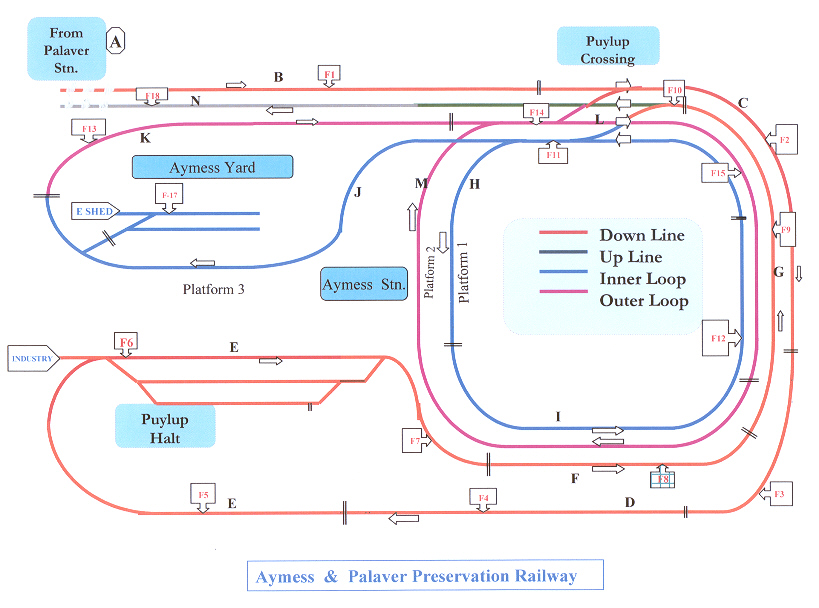Ken Sherwood's ...
What’s
in a Name?
When my sons were young, one had an interest in British Railways and the
other in North American ones. So I built a simple two-station layout for them to
play with. One station was British, and because at the time BR was “a mess”
the station name became Aymess. The other was a NA station and reflected the
propensity of Americans to talk too much, and was named Palaver. Boys being boys
they liked to crash opposing locos, and so caused “pile ups”. Hence the name
Puyallup for the station Halt.
Background.
In the sixties I had dabbled in railroad models as an adjunct to my main
hobby of building flying model aircraft. All modelling was put on the back
burner for many years as my job required travelling throughout Europe. However
the ‘Railway’ bug had bitten, and thus whenever I was in the UK I bought
steam locos. but not having ever used train travel in the UK, -
apart from a few short trips on the ‘Marlow Donkey’ - I built up an
eclectic mix of locos. Upon resuming modelling I had very little knowledge
(nothings changed there}, and even less loyalty to a given railway area, so how
to justify these locos all running on the same rails. As Preservation Railways
seemed to be springing up all over the UK it seemed logical to turn the Aymess
& Palaver Railway into the Aymess & Palaver Preservation Railway.
In it’s first few incarnations I created my own decals for both passenger and
goods locos along with a Company motto of “Trust in Us You Have No Choice”
As I started to read more about the regional railways I took a fancy to
the WR and the GWR, which led me to dispose of many locos, retaining only those
to be found on GWR or BR Western Region rails. The result has been that although
the APPR is not based on any ‘real location’, it is assumed to lie between
Berkshire and Wiltshire, it does broadly follow GWR practice. With only a few
exceptions all trains are pre 1970, and where possible are actually preserved
around the UK.
On retiring to Rockwood I built version five of the APPR which was
somewhat experimental trying out various scenic techniques. There then followed
a few years when the modelling stopped! However when Mike Walton invited me to
be one of ‘The Lively Lads,’ running Lostock , my enthusiasm was rekindled,
but then off he went to Germany, ….so
Genesis.
With
the modelling ‘bug’ now restored, I decided to build APPR Mk.Six using some
of Mikes design principles, and with the following parameters in mind:
-
1.Within a 16’ square, to have a length of run that would allow 3 or 4
trains to run at one time without obvious tail chasing. This has been achieved by
making, essentially, a ‘dog bone’ bent over three levels. As a result trains
can take from 3 to 6mins to complete a full circuit.
2.To have double track main line running. Although a single-track line, the folded dog bone gives the
appearance of a double track mainline.
3.To provide interest and present operational challenges for two or
three operators, and the potential for timetable operation.
There is about 400’ of running line, in an ‘out and back’ format,
which starts at the upper terminus of
Palaver, then passes through the middle level station at Aymess, and on to
the lower level at Puyallup Halt. The lower levels may be used for continuous
running with the Aymess loop used to reverse trains for returning to Palaver
terminus.
The upper level terminus of Palaver, has associated loco facilities,
consisting of a 2-road shed, a Coaling Stage, and 78ft turntable..

Operation
Sequences.
Trains leave Palaver, then: -
1.Short Route.
Traverse the Main Loop (via Puyallup) and return to Palaver Terminus.
2.Intermediate Route.
Go round the Main Loop then cross over from the Up Line into Aymess
Platform 1. Leaving Aymess on the Inner Loop trains go to Platform 3 before
taking the Reversing Loop onto the Down Line and return to Palaver.
3.
Long Distance.
As in (2) but from Platform 3 take the Outer Loop, which returns the
train to platform2. On departing Platform 2 go out onto cross over onto Down
Line and return to Palaver.
OR
For continuous running, cross from the Up line back onto Inner Loop to
Aymess 3.

Electrical
The
layout wiring is straight forward, being wired under conventional Cab Control
with blocks operated by SPDT switches. Because of the size of the layout, wiring
is all colour coded using telephone wire, this gives up to thirty colour
pairings. On each baseboard there are block terminals which allows for easy
trouble shooting. Each block within the layout can accommodate two rakes
consisting of loco plus six
coaches.
Points
use ‘push to make’ buttons, operating a mixture of H & M, PECO
and Seep point motors. Capacitor Discharge Units are used to ensure that
multiple point motors can be thrown at one time. The Double Slips and Three Way
point use diode matrices for control and Crossovers are joined electrically thus
allowing single button operation in all cases.
Scenery.
I have tried to create an environment in which the railway operates.
Hence there is Palaver Village with its small High Street, and in the background
we have Aymess Town with associated
suburbs. The layout has more road traffic – cars and lorries- than most
layouts mainly to enhance the overall atmosphere. Stations have connecting roads
and some industry to justify the road traffic. To add interest, there are
several dioramas within the layout. At the present time there is only basic
scenery and there is a lot to be done in creating grasslands, trees and general
background detail. On the railway itself the major work is to build and add
signalling as well as railway signage.
Buildings.
These are a mixture of card kits from Superquick and Metcalfe( suitably
modified and weathered ) along with some scratch built buildings. The latter
comprise a Coaling Stage and Engine shed based on Didcot; a timber framed Goods
Shed of Campdon; Aymess Station modelled after High Wycombe -complete with
detailed interior , a waste of time as you can’t see it, and the freelance
builders yard of Rackham and Sherwood.
Conclusion